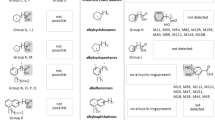Abstract
The oil-oxidizing potential of associative rhizobacteria of the genus Azospirillum was studied under laboratory conditions. After screening, A. brasilense strain SR80 was chosen for further investigation. The strain was capable of degrading 56.5% of crude oil (added in a concentration of 1%) over 14 days in a medium containing malate as an additional source of carbon and energy. Studies of associative properties showed that the strain had positive chemotaxis to wheat root exudates, colonized wheat roots, and produced indole-3-acetic acid. The synthesis of indole-3-acetic acid was not inhibited by oil. Under hydroponic conditions, crude oil stimulated growth of A. brasilense SR80, which promoted development of the wheat root system in the presence of oil and enhanced the level of oil degradation by the plant-microbial association.
Similar content being viewed by others
REFERENCES
Siciliano, S.D. and Germida, J.J., Mechanisms of Phytoremediation: Biochemical and Ecological Interactions between Plants and Bacteria, Environ. Rev., 1998, vol. 6, pp. 65–79.
Walton, B.T., Hoylman, A.M., Perez, M.M., Anderson, T.A., Johnson, T.R., Guthrie, E.A., and Christman, R.F., in Bioremediation through Rhizosphere Technology, Anderson, T.A. and Coats, J.R., Eds. Washington: Am. Chem. Soc., 1994, pp. 82–92.
Gunther, T., Kirsche, B., and Fritsche, W., in Bioremediation of Contaminated Soil, Wise, D.L., et al., Eds., New York: Marcel Dekker, 2000, pp. 285–293.
Ismailov, N.M., Microflora and Enzyme Activities in Oil-contaminated Soils, Vosstanovlenie neftezagryaznennykh pochvennykh ekosistem (Bioremediation of Oil-contaminated Soil Ecosystems), Glazovskaya, M.A., Ed., Moscow: Nauka, 1988.
Kireeva, N.A., Mikrobiologicheskie protsessy v neftezagryaznennykh pochvakh (Microbiological Processes in Oil-contaminated Soils), Ufa: Bashk. Gos. Univ., 1994.
Steenhoudt, O. and Vanderleyden, J., Azospirillum, a Free-Living Nitrogen-Fixing Bacterium Closely Associated with Grasses: Genetic, Biochemical and Ecological Aspects, FEMS Microbiol. Rev., 2000, vol. 24, pp. 487–506.
Miller, J.H., Experiments in Molecular Genetics, Cold Spring Harbor: Cold Spring Harbor Lab., 1972.
Tarrand, J., Krieg, N., and Dobereiner, J., A Taxonomic Study of the Spirillum lipoferum Group, with Descriptions of a New Genus Azospirillum gen. nov. and Two Species, Azospirillum lipoferum (Beijerinck) comb. nov. and Azospirillum brasilense sp. nov., Can. J. Microbiol., 1978, vol. 24, pp. 967–980.
Dobereiner, J. and Baldani, V.L.D., Selective Infection of Maize Roots by Streptomycin-Resistant Azospirillum lipoferum and Other Bacteria, Can. J. Microbiol., 1979, vol. 25, pp. 1264–1269.
MacClung, S., Recent Developments in Microbiological Techniques, Annu. Rev. Microbiol., 1949.
Koronelli, T.V. and Komarova, T.I., The Chemotactic Reactions of a Paraffin-oxidizing Pseudomonas aeruginosa Strain, Mikrobiologiya, 1982, vol. 51, no.4, pp. 689–690.
Metody izucheniya pochvennykh mikroorganizmov i ikh metabolitov (Methods for Studying Soil Microorganisms and Their Metabolites), Krasil’nikova, Ed., Moscow: Mosk. Gos. Univ., 1966.
Yakovlev, A.D., Poroshkovye kraski (Powdered Paints), Leningrad: Khimiya, 1987.
Barkovskii, A.L., Boullant, M.-L., and Balandeau, J., 1979 Phenolic Compounds Respired by Bacteria, in Bioremediation through Rhizosphere Technology, Anderson, T.A. and Coats, J.R., Eds., Washington: Am. Chem. Soc, 1994, pp. 28–42.
Okon, Y. and Vanderleyden, J., Root-Associated Azospirillum Species Can Stimulate Plants, ASM News, 1997, vol. 63, pp. 366–370.
Umali-Garcia, M., Hubbell, D.N., Gaskins, M.H., and Dazzo, F.B., Association of Azospirillum with Grass Roots, Appl. Environ. Microbiol., 1980, vol. 39, pp. 219–226.
Barbieri, P. and Galli, E., Effect on Wheat Root Development of Inoculation with an Azospirillum brasilense Mutant with Altered Indole-3-Acetic Acid Production, Res. Microbiol., 1993, vol. 144, pp. 69–75.
Author information
Authors and Affiliations
Additional information
__________
Translated from Mikrobiologiya, Vol. 74, No. 2, 2005, pp. 248–254.
Original Russian Text Copyright © 2005 by Muratova, Turkovskaya, Antonyuk, Makarov, Pozdnyakova, Ignatov.
Rights and permissions
About this article
Cite this article
Muratova, A.Y., Turkovskaya, O.V., Antonyuk, L.P. et al. Oil-oxidizing potential of associative rhizobacteria of the genus Azospirillum . Microbiology 74, 210–215 (2005). https://doi.org/10.1007/s11021-005-0053-4
Received:
Issue Date:
DOI: https://doi.org/10.1007/s11021-005-0053-4




